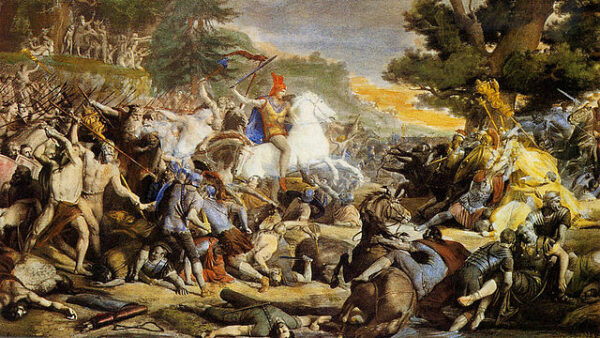On September 11, 9 AD, the Empire of Rome saw its expanding borders stopped in its tracks. The Battle of the Teutoburg Forest, also known as the Varian Disaster, was a pivotal event in Roman history that took place in 9 CE. It was a catastrophic defeat for the Roman Empire, led by General Publius Quinctilius Varus, at the hands of a coalition of Germanic tribes led by Arminius, a chieftain of the Cherusci tribe. The battle unfolded in the dense Teutoburg Forest in what is now modern-day Germany.
Arminius, who had previously served as an officer in the Roman army, used his knowledge of Roman tactics and terrain to ambush Varus’ forces.
Smithsonian Magazine writes, “Arminius’ motives are obscure, but most historians believe he had long harbored dreams of becoming king of his tribe. To achieve his goal, he concocted a brilliant deception: he would report a fictitious “uprising” in territory unfamiliar to the Romans, then lead them into a deadly trap. A rival chieftain, Segestes, repeatedly warned Varus that Arminius was a traitor, but Varus ignored him. “The Romans,” says Peter S. Wells, a specialist in Iron Age European archaeology at the University of Minnesota, “thought they were invincible.”
Arminius had instructed the Romans to make what he had described as a short detour, a one- or two-day march, into the territory of the rebels.The legionnaires followed along rudimentary trails that meandered among the Germans’ farmsteads, scattered fields, pastures, bogs and oak forests. As they progressed, the line of Roman troops—already seven or eight miles long, including local auxiliaries, camp followers and a train of baggage carts pulled by mules—became dangerously extended. The legionnaires, wrote third-century historian Cassius Dio, “were having a hard time of it, felling trees, building roads, and bridging places that required it. . . . Meanwhile, a violent rain and wind came up that separated them still further, while the ground, that had become slippery around the roots and logs, made walking very treacherous for them, and the tops of the trees kept breaking off and falling down, causing much confusion. While the Romans were in such difficulties, the barbarians suddenly surrounded them on all sides at once,” Dio writes of the preliminary German skirmishes. “At first they hurled their volleys from a distance; then, as no one defended himself and many were wounded, they approached closer to them.” Somehow, the command to attack had gone out to the German tribes. “This is pure conjecture,” says Benario, “but Arminius must have delivered a message that the Germans should begin their assault.”
The nearest Roman base lay at Haltern, 60 miles to the southwest. So Varus, on the second day, pressed on doggedly in that direction. On the third day, he and his troops were entering a passage between a hill and a huge swamp known as the Great Bog that, in places, was no more than 60 feet wide. As the increasingly chaotic and panicky mass of legionnaires, cavalrymen, mules and carts inched forward, Germans appeared from behind trees and sand-mound barriers, cutting off all possibility of retreat. “In open country, the superbly drilled and disciplined Romans would surely have prevailed,” says Wells. “But here, with no room to maneuver, exhausted after days of hit-and-run attacks, unnerved, they were at a crippling disadvantage.”
Varus understood that there was no escape. Rather than face certain torture at the hands of the Germans, he chose suicide, falling on his sword as Roman tradition prescribed. Most of his commanders followed suit, leaving their troops leaderless in what had become a killing field. “An army unexcelled in bravery, the first of Roman armies in discipline, in energy, and in experience in the field, through the negligence of its general, the perfidy of the enemy, and the unkindness of fortune. . . . was exterminated almost to a man by the very enemy whom it has always slaughtered like cattle,” according to the a.d. 30 account of Velleius Paterculus, a retired military officer who may have known both Varus and Arminius.
Just a few survivors miraculously fled into the forest and found safety. When they returned with the shocking news, it greatly astonished the Romans. Some believed it was due to supernatural forces, even suggesting that a statue of the goddess Victory had mysteriously turned in the opposite direction. Suetonius, a historian who wrote about a century after the battle, claimed that this defeat had almost caused the downfall of the entire Roman Empire.
The outcome of the battle was a slaughter for the Romans. It is estimated that around 20,000 Roman soldiers were killed, and their eagles, a symbol of Roman military power, were captured by the Germanic tribes. The defeat marked the end of Roman efforts to conquer Germania east of the Rhine River. Emperor Augustus was said to have been devastated upon hearing the news, reportedly banging his head against the walls of his palace and shouting, “Varus, give me back my legions!”
The Battle of the Teutoburg Forest had lasting consequences. It not only halted Roman expansion into Germania but also established a cultural and geographical divide that persisted for centuries. The event is still remembered in modern Germany as a symbol of national resistance against foreign invaders.
Today, the site of the battle is a historical landmark, and archaeological excavations continue to shed light on this significant moment in history. The death for the Romans was so thorough that even today, people visiting the forest will stumble upon artifacts from the legions. Most recently, the only completely intact Roman armor from the era was recovered and placed on display in a nearby museum.






